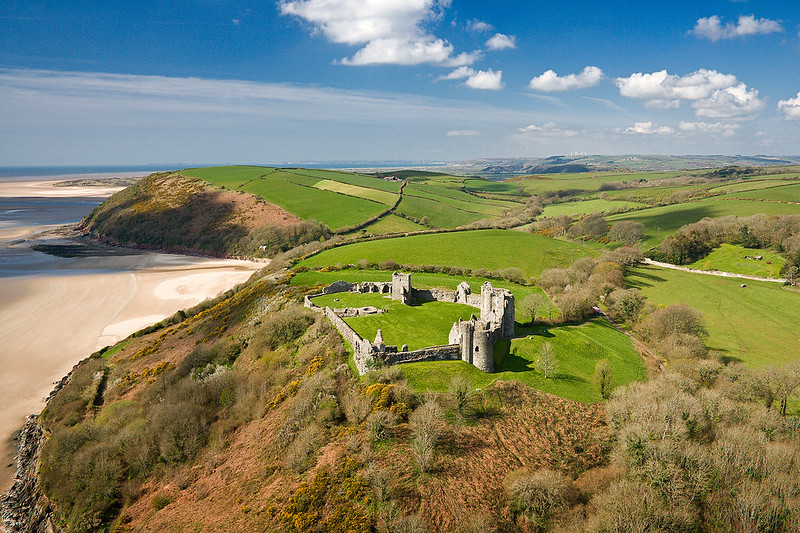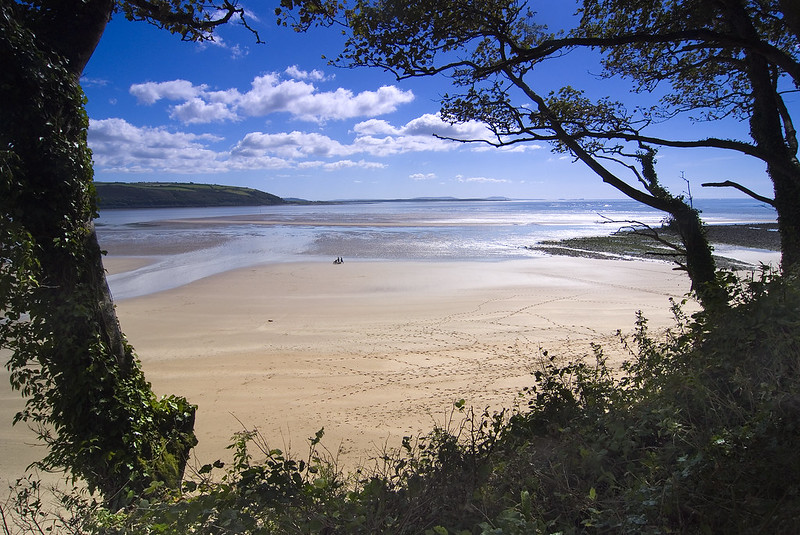Nature
Image: Llansteffan Castle and Beach

Why is green and blue infrastructure important for nature?
In its State of Nature Report 2019, Natural Resources Wales highlighted how environmental pressures are causing significant global biodiversity decline.
It explains how the rate of species extinctions is accelerating – with 17% of species in Wales at risk of extinction. Wales has already lost birds like turtle doves and corn buntings. This is being driven by issues including agricultural management, climate change, urbanisation, pollution, hydrological change, invasive species and a lack of woodland management.
Climate change is also likely to have a range of impacts on habitats and species as conditions become unsuitable for them to thrive.
Without good green and blue infrastructure alongside increasingly urban and managed landscapes, we undermine nature’s ability to be productive, resilient and adapt to a changing climate.
However, there are signs of hope – woodland cover in Wales has risen from 4% in the early 1900s to 15% today, and polecats are making a slow recovery. Documents like the Nature Recovery Action Plan for Wales (2020-21) are providing a stronger focus on rebuilding nature recovery networks.
What does national and regional policy say?
One of the seven well-being goals set out in the Well-being of Future Generations (Wales) Act 2015 is a ‘resilient Wales’. This requires the maintenance and enhancement of a biodiverse natural environment and creating capacity to adapt to climate change.
The National Natural Resources Policy (2017) aims to help fulfil the goals of the Well-being of Future Generations (Wales) Act 2015 by delivering nature-based solutions. It highlights that investing in natural resources can both increase ecosystem resilience and deliver health and well-being benefits.
The Environment (Wales) Act 2016, places specific duties on public bodies. These require them to maintain and enhance biodiversity and promote the resilience of ecosystems. The Act also made it a duty for Natural Resources Wales to produce Area statements – including one for the South West. Key priorities in this statement include ensuring sustainable land management, reversing the decline of biodiversity and adapting to a changing climate.
Building on this, the updated Nature Recovery Action Plan for Wales (2020-21) reflects the need to build resilient ecological networks across the country’s whole land and seascape.
The ‘Future Wales’ National Plan to 2040 sets the direction for future development in Wales. Policy 9 (Resilient Ecological Networks and Green Infrastructure) requires identified areas to be safeguarded as ecological networks, and to identify opportunities for GBI to be maximised as part of placemaking initiatives.
Finally, the Welsh Government has produced national-level habitat strategies – including Woodland for Wales. This 50-year strategy provides a framework to ensure Wales will be known for its high-quality woodlands that enhance the landscape, are appropriate to local conditions and have a diverse mixture of species and habitats.
What does local policy say?
Strategic Policy 14 of Carmarthenshire’s Local Development Plan (on Protection and Enhancement of the Natural Environment) requires development to reflect the need to protect, and wherever possible enhance, the county’s natural environment. This takes account of designated sites, wildlife corridors, open countryside, agricultural land, and soil and water resources.
The Carmarthenshire Nature Recovery Action Plan focuses on ecological resilience with connectivity as a central theme.
Carmarthenshire Council also facilitates the Carmarthenshire Nature Partnership. This is made up of over 15 organisations including the Council, Welsh Government, and non-government wildlife bodies, wildlife charities and voluntary groups. All partners work together to conserve and enhance Carmarthenshire’s biodiversity.
How is green and blue infrastructure currently serving nature in Carmarthenshire?
Image: Scott's Bay at Llansteffan Beach

Biodiversity greatly influences the character of Carmarthenshire’s landscape. There is a great deal to be valued and to protect.
For example, Carmarthenshire supports 45% of all known marsh fritillary butterfly populations in Wales, an internationally important and threatened species. It is also home to the only known example in mainland Britain of a ‘turlough’ lake.
Carmarthenshire is home to a significant network of statutory designated sites – these include Special Protection Areas (SPAs) such as Burry Inlet, Special Areas of Conservation (SACs) such as the River Tywi and SSSIs. A wider network of Local Nature Reserves and Local Wildlife Sites help to buffer and connect the designated sites. All can be explored on our interactive map.
Many of Carmarthenshire’s biodiversity features are concentrated around its coast. Almost the entire coastline is composed of Welsh priority habitat (see interactive map), including a significant proportion of the Welsh sand dunes.
Meanwhile in the rugged uplands, globally rare blanket bog coats the landscape. These, along with other types of peatland, support specialised and often threatened wildlife.
Networks of woodlands, grasslands and wetlands also make important contributions to habitat diversity across the county.
Stakeholders consulted for this Strategy highlighted the absence of nature within Carmarthenshire’s network of towns and other urban areas where people live. They cited an absence of ‘wild areas’ and ongoing use of pesticides as local problems.
What are the challenges and pressures?
There are increasing concerns over the condition of Carmarthenshire’s most sensitive designated sites.
Carmarthenshire-specific biodiversity monitoring data is not available. However, in the south west of Wales 27% of Sites of Special Scientific Interest (SSSIs) and 75% of Special Areas of Conservation (SACs) are in unfavourable condition. It is important that protected sites are of high quality to support functional ecosystems and provide the services we depend on.
Carmarthenshire’s water environment, and the habitats it supports, is under particular pressure.
This is the result of a combination of causes – including agriculture and rural land management practices, acidification due to air pollution (exacerbated by historic coniferous forestry) artificial barriers, abandoned mines and discharges from wastewater treatment works.
In 2021 the four SAC rivers in Carmarthenshire were identified as being in unfavourable condition or close to unfavourable condition due to nutrient pollution. These rivers support habitats and species that are considered critical to biodiversity. The rivers also provide an important context for recreational use and tourism. Read more on this from Natural Resources Wales.
In the wider landscape surrounding designated sites, habitat loss and fragmentation are among the largest causes of nature’s decline.
Agricultural land is one cause of fragmentation, as the county of Carmarthenshire is dominated by agricultural landscapes. Changes to land management in Wales have caused the loss of more than 90% of semi-natural grassland habitats since the 1930s, removing suitable nesting habitat for grassland and farmland bird species.
Nature: Summary of key Issues
Efforts must be made to:
- protect and retain existing biodiversity assets and connections.
- increase the quantity of biodiversity assets by improving the biodiversity value of existing green spaces within and around towns.
- improve the quality of several sites designated for biodiversity value that are in poor condition.
- tackle the fragmentation of habitat networks across the wider agricultural landscape.
- address the failing condition of the water environment along blue corridors.
- address the impact of climate change on biodiversity.